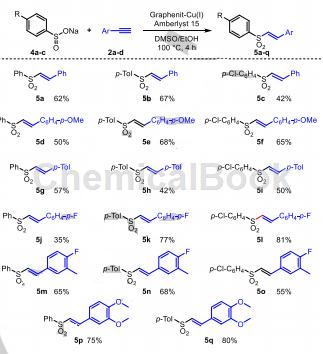Background and overview[1]
Phenyl TRANS-styryl sulfone can be used as pharmaceutical synthesis intermediates. If phenyl TRANS-styryl sulfone is inhaled, move the patient to fresh air; if skin contact occurs, take off contaminated clothing and wash the skin thoroughly with soap and water. If you feel uncomfortable, seek medical attention; if the eyes are clear In case of contact, separate eyelids, rinse with running water or saline, and seek medical attention immediately; if ingested, rinse mouth immediately, do not induce vomiting, and seek medical attention immediately.
Apply[1]
Phenyl TRANS-styryl sulfone can be used to prepare a cleaning liquid for pre-cleaning of flat glass substrates. According to mass percentage, its components are: potassium hydroxide 1 to 20%, alcohol amine 1 ~15%, sulfone and/or sulfoxide compounds 5-35%, alcohol compounds 1-25%, surfactant 0.1-15%, and the remaining amount is water. The alcohol amine is one or more of monoethanolamine, triethanolamine, diglycolamine, isopropanolamine, methyldiethanolamine, dimethylethanolamine, and hydroxyethylethylenediamine; the sulfone and /or the sulfoxide compound includes phenyl TRANS-styryl sulfone.
Preparation[2]
Phenyl TRANS-styryl sulfone is prepared as follows: In a vial, dissolve sulfonate 4 (1.5 equiv), Amberlyst 15 (140 mg) and graphene-copper(I) (5%) in DMSO:EtOH1 :1. Seal the vial and suspend in the Vortex system for 3 minutes at room temperature. Alkyne 2 (1 equiv) was added and the reaction was maintained at 100°C with continuous stirring. After 24 hours, the crude reaction product was filtered through HPLC filter. The organic phase was dried over Na2SO4, and the solvent was removed under reduced pressure to obtain the desired products 5a-5q. (where 5a is phenyl TRANS-styryl sulfone).

Main reference materials
[1] CN201410659453.5 A cleaning fluid for pre-cleaning of flat glass substrates and its application
[2] Astudyofgraphene-basedCu-catalysts.Cu(I)nanoplateletsforbatchandcontinuous-flowapplications



 微信扫一扫打赏
微信扫一扫打赏
